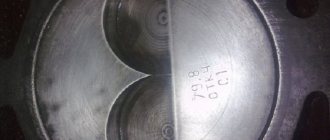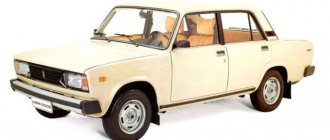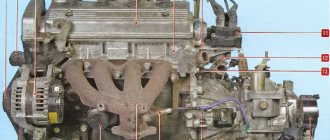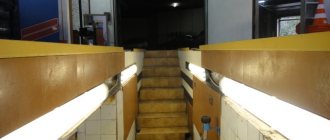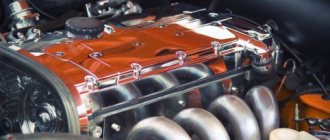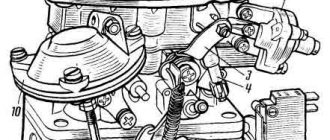Characteristics of ICE 2105
The ICE of the fourth series 2105 was designed by analogy with the Ford Pinto engine, therefore it received a timing belt drive and attachments, and protection against bending/jamming of the valves in the event of its breakage while driving. The improved technical specifications are as follows:
| Manufacturer | VAZ |
| Engine brand | VAZ-2105 |
| Years of production | 1979 – 1994 |
| Volume | 1.3 l (1294 cm3) |
| Power | 47.2 kW (64 hp) |
| Torque | 94 Nm (3400 rpm) |
| Weight | 104 kg |
| Compression ratio | 8,8 |
| Nutrition | carburetor DAAZ-2105 Ozone |
| Motor type | in-line |
| Number of cylinders | 4 |
| Location of the first cylinder | near the timing belt |
| Number of valves on each cylinder | 2 |
| Cylinder head material | aluminum alloy |
| Allowable warpage | manifold gaskets (intake/exhaust) 0.08 mm cylinder head gasket 0.05 mm |
| Valve seat | width 2 – 2.4 mm, angle 45° |
| Camshaft | one upper cylinder head inside, phase width 232°, exhaust valve advance 42°, intake valve lag 40° |
| Camshaft oil seal | diameters – 40 mm, 56 mm, width 7 mm |
| Cylinder block material | cast iron |
| Cylinder diameter | class A – 79 – 79.01 mm class B – 79.01 – 79.02 mm class C – 79.02 – 79.03 mm class D – 79.03 – 79.04 mm class E – 79.04 – 79.05 mm |
| Pistons and rings | piston made of aluminum alloy with tin coating, cast iron rings, compression outside chrome plated (top) and beveled (bottom) |
| Piston diameter | class A – 78.94 – 78.95 mm class C – 78.96 – 78.97 mm class E – 78.98 – 78.99 mm |
| Gaps | piston/cylinder wall – 0.153 – 0.173 mm (standard) or 0.19 mm (maximum) piston rings – 110 mm relative to the cut plane |
| Upper compression ring | 1.535 – 1.555 mm |
| Lower compression ring | 3.957 – 3.977 mm |
| Oil scraper ring | 2.015 – 2.035 mm |
| Gap between piston groove and ring | 0.03 – 0.07 mm |
| Crankshaft | cast iron, casting |
| Number of main bearings | 5 |
| Gearbox neck diameter | 50.795 – 50.775 mm |
| Main journal gap | 0.1 – 0.5 mm |
| Connecting rod bearings | shaft journal diameter – 47.814 mm liner thickness – 1.448 mm liner width – 28.025 – 28.975 mm |
| Crankshaft oil seals | front – diameters 42 mm, 60 mm, width 7 mm rear – diameters 85 mm, 105 mm, width 10 mm |
| Piston stroke | 66 mm |
| Fuel | AI-93 (A-76 allowed) |
| Environmental standards | Euro 1 |
| Fuel consumption | highway – 6 l/100 km, combined cycle 8 l/100 km city – 10 l/100 km |
| Oil consumption | maximum 0.7 l/1000 km |
| Engine oil for 2105 | 5W-30 and 15W-40 |
| Engine oil volume | 3.75 l |
| Replacement frequency | every 55,000 km |
| Operating temperature | 80° |
| Motor life | declared 200,000 km actual 500,000 km |
| Adjustment of valves | nuts and feeler gauge |
| Cooling system | forced, antifreeze-A40 |
| Coolant quantity | 9.75 l |
| water pump | polymer impeller, mounted on a block |
| Ignition | distributor ATE-2 |
| Candles for 2105 | original – A17-DV, |
| Gap between spark plug electrodes | 0.5 – 0.6 mm |
| Timing belt | 122 teeth |
| Cylinder operating order | 1-3-4-2 |
| Air filter | dry with replaceable cardboard cartridge and pre-cleaner, temperature adjustment according to the season |
| Oil filter | recommended Mann W914/2 |
| Flywheel | 129 teeth, 0.62 kg internal hole diameter – 25.67 mm outer diameter – 27.75 mm number of mounting holes – 6 pieces no offsets |
| Flywheel mounting bolts | M10x1.25 mm, length 23.5 mm, |
| Valve stem seals | Manufacturers Horse or Corteco |
| Compression | pressure in the cylinders from 11 – 14 bar, pressure difference in individual cylinders within 1 bar |
| Oil temperature | 80°С |
| Thermostat temperature | 80 – 84°С |
| Valve pressure inside the radiator cap | 0.7 – 1 bar |
| Content of harmful products in the exhaust | CH <200%, CO <0.5% |
| XX speed | 700 – 800 min-1 |
| Tightening force of threaded connections | spark plug – 20 Nm flywheel – 60 + 90° Nm clutch bolt – 20 Nm bearing cap – 65 Nm + 90° (main) and 30 Nm + 90° (rod) cylinder head – 4 stages 40 Nm, 60 Nm + 90° + 90° |
A complete description of the internal combustion engine parameters is contained in the official manual of the manufacturer. It states that opposite the valves in the engine pistons there are slots that ensure the safety of the internal combustion engine in the event of a timing belt break - the piston will not be able to “meet” the valve physically. The user simply replaces the rubber product; no major repairs are required.
Groove in the piston to protect the valve
Review of the Lada 2105 model
The VAZ-2105 car was produced at the Tolyatti Automobile Plant (as well as at the KraSZ factories in Ukraine and Lada Egypt in Egypt) for 31 years - from 1979 to 2010, i.e. it was in production longer than any other VAZ model. By the end of the 2000s, thanks to the minimum configuration, the “five” was cheaper than each of the Volzhsky Automobile Plant models produced at that time - 178 thousand rubles in 2009.
The VAZ-2105 car was produced at the Tolyatti Automobile Plant from 1979 to 2010
Having replaced the first-generation Zhiguli, the VAZ-2105 received a more contemporary appearance at that time with angular shapes and matte black decorative elements instead of the previously used chrome ones. The creators of the new model sought not only to simplify assembly, but also to achieve an acceptable cost for the car . For example, the abandonment of chrome-plated parts made it possible to get rid of the long and labor-intensive technological process of applying several layers of non-ferrous metals to steel. Among the innovations that were not present on previous VAZ models were:
- timing belt (instead of the previously used chain);
- polyurethane panels in the interior, made by solid stamping;
- block headlights equipped with hydraulic corrector;
- combination of clearance lights, turn signals, reversing lights, brake lights and fog lights under one rear lamp shade;
- heated rear window as standard.
In addition, the rotating wind triangles on the windows of the front doors of the new car were removed, and side nozzles began to be used to blow these windows. The driver could now adjust the position of the side mirrors from the passenger compartment; height-adjustable headrests were provided for front passengers.
A very good car for the money, I bought it as my first car and didn’t regret it later. I drove it for 1.5 years, invested a little after the previous owner and hit the road! During operation, no special problems arose, just little things related to maintenance, you just need to change everything on time and take care of the car, and not wait until it falls off on its own! Possibility of tuning, a large selection of spare parts, and all auto stores have almost all spare parts, not counting disassembly ones.
Alexander
https://www.infocar.ua/reviews/vaz/2105/1983/1.3-mehanika-sedan-id21334.html
The rotating wind triangles on the windows of the front doors of the new car were removed, and side nozzles began to be used to blow these windows
More about tuning the VAZ 2105: https://bumper.guru/klassicheskie-modeli-vaz/tyuning/tyuning-vaz-2105.html
The VAZ-2105 body number can be found under the hood near the windshield closer to the passenger seat . The vehicle's registration data is indicated on a special plate located on the bottom shelf of the air supply box. In addition, the vehicle identification code indicated in the table is duplicated in the luggage compartment. To see it, you need to use a Phillips screwdriver to unscrew the screw holding the rear wheel arch trim and remove the trim.
The vehicle's passport data is indicated on a special plate located on the bottom shelf of the air supply box; next to the plate (1 with a red arrow) VIN is stamped (2 with a red arrow)
The summary plate shows:
- 1 - number used for selecting spare parts;
- 2 - manufacturer;
- 3 — conformity mark and vehicle type approval number;
- 4 — VIN of the car;
- 5 — engine brand;
- 6 — maximum load on the front axle;
- 7 — maximum force on the rear axle;
- 8 — marking of version and configuration;
- 9 - maximum permissible weight of the machine;
- 10 is the maximum permissible weight of the vehicle with trailer.
Video: introduction to the first version of the VAZ-2105 model
Design nuances
To obtain the above engine characteristics, the manufacturer carried out experiments:
- piston stroke reduced to 66 mm;
- the cylinder diameter, on the contrary, is increased to 79 mm.
The result was a revving, powerful engine with an aluminum valve cover that absorbed the sounds of the drive. Another feature of the internal combustion engine is the fastening of the timing belt pulley - users do not need to unscrew the bolt on the crankshaft, unlike previous VAZ engine models.
Design 2105
In the operating instructions, the manufacturer recommends which oil to pour into the engine - 5W30 - 15W40.
Description
In 1979, VAZ engineers first presented a new model of the power unit for the VAZ 2105 car. Production of the engine continued until 1994. During the production process, the base model was subjected to repeated modernization.
The engine received an index according to the car brand - VAZ-2105. The main differences from previously produced internal combustion engines were the timing drive, ShPG, and fuel supply system.
The VAZ-2105 is a 1.3-liter gasoline in-line four-cylinder naturally aspirated engine with a power of 64 hp. s and torque 94 Nm.
VAZ-2105
Installed on VAZ cars:
- 2105 /sedan/ (1979-2006);
- 2104 /station wagon/ (1984-2012);
- 21072 /sedan/ (1982-2008).
The cylinder block is cast iron, not lined. The peculiarity was increased resistance to overheating.
Achieved by using special low-alloy cast iron. The cylinders are bored inside the block and honed.
The crankshaft and connecting rods are made according to a standard design.
The configuration of the piston crown has been changed. As a result of its counterbore, bending of the valves and destruction of the cylinder head when meeting the valves as a result of a broken timing belt are eliminated.
The cylinder head is made of aluminum alloy. A camshaft, eight valves, their guides and seats are attached to it. An asbestos gasket impregnated with graphite is installed between the cylinder head and the cylinder block.
Another new feature is that the camshaft is mounted on a special removable bed.
The main highlight of the engine is the timing belt drive.
VAZ-2105 timing belt drive diagram
This innovation was used for the first time on VAZ engines. The engine has become more revving and at the same time less noisy. The disadvantages of the timing belt include the absence of hydraulic compensators, which somewhat complicates the maintenance of the unit.
The carburetor in the fuel supply system has been modernized. Now it has an EPHH valve. As a result, fuel consumption has decreased.
The remaining design changes are not significant and correspond to the classic VAZ engines.
Complete diagram of the internal combustion engine
The simplicity of the motor design ensured its high reliability and durability. With careful care and reasonable operation, major repairs were not required for decades.
What cars were equipped with ICE 2105?
This modernization could not satisfy users of the domestic automobile industry. The main drawback was the regular breakage of the timing belt, AvtoAZ management reduced production volumes, then removed the 2105 engine from production, so only three modifications of the Zhiguli were equipped with the engine:
- 2105 sedan;
- 2104 station wagon;
- 21072 sedan.
Four with engine 2105
Currently, tuning for the engine of this series is not difficult, but among the operating fleet of Zhiguli “fives” with the “native” engine there are very few left.
Pros and cons
Subject to compliance with maintenance and operation regimes, major repairs were not required for the machines for decades. In capable hands, the 2105 engine produced in 1989 is still in use today, and the timing belt life is enough for 40,000 km. If there are no problems with consumables, then the demand for spare parts is not fully satisfied. For example, the cylinder head is always available, and the intake manifolds are welded on site.
Intake manifold
VAZ 21054 injector
Carburetors from different manufacturers are no different in operation; they are all made in order to create a fuel-air mixture. For this, there are already known proportions. The next step is to enter a chamber where this mixture ignites and burns completely.
There are different carburetors and injectors: float - it is the most popular and famous compared to the others; needle-shaped - it is less common; and a very rare one - a bubbler carburetor, this carburetor is not known to everyone; it is used very rarely. Carburetor tuning for VAZ 21054, VAZ 21053 is a popular and therefore popular product on the domestic market.
Maintenance regulations
| Maintenance object | Time or mileage (whichever comes first) |
| Timing belt | replacement after 40,000 km |
| Battery | 1 year/20000 |
| Valve clearance | 2 years/20000 |
| Crankcase ventilation | 2 years/20000 |
| Belts that drive attachments | 2 years/20000 |
| Fuel line and tank cap | 2 years/40000 |
| Motor oil | 1 year/10000 |
| Oil filter | 1 year/10000 |
| Air filter | 1 – 2 years/20000 |
| Fuel filter | 4 years/20000 |
| Heating/Cooling Fittings and Hoses | 2 years/40000 |
| Coolant | 2 years/40000 |
| Oxygen sensor | — |
| Spark plug | 1 – 2 years/20000 |
| Exhaust manifold | 2 years |
Knowing what kind of oil is used in the engine and the type of liquid with which the cooling system is filled, you can carry out maintenance of the “five” internal combustion engine yourself.
Causes of malfunctions and their elimination
In principle, the 2105 engine has all the typical malfunctions of carburetor in-line internal combustion engines:
- clogging of the fuel system, fuel pump, carburetor, throttle, jets and filter;
- exhaustion of the life of the air filter and microswitch;
- failure of the ignition system and stuck valves and piston rings;
- breakdown of gaskets and seals, misadjustment of cam gaps;
- production of cylinders/pistons, bearing shells;
- loosening the flywheel bolts and attachment drive belts.
But the engine diagram allows you to avoid major repairs if the timing belt breaks by 100%.
Engine malfunctions and repairs 2105
The VAZ 2105 engine is the same 21011, the power is slightly lower than that of the eleventh, the main difference is that the VAZ 2105 engine has a belt. The use of a timing belt is designed to reduce engine noise. One of the positive qualities is that the 2105 engine does not bend the valves. Cons of the 2105 engine... the 2105 engine still requires valve adjustment. In addition, the 2105 engine stalls, this may be caused by the thickened oil in the box not being warmed up. Just warm up the car in the cold season and only then start driving. Problems. It is not uncommon for a VAZ 2105 engine to seize up; this is most likely caused by a lack of oil or a reluctance to change it on time; such savings can easily backfire. Just as the 21011 VAZ 2105 engine smokes, the main causes and solutions to this problem are described in the article about 2101 HERE in the “General Description” section. A knock in the VAZ 2105 engine indicates that the valves are not adjusted, go to a mechanic or adjust them yourself differently with an increase in the thermal gap, in addition to additional noise, you will experience a decrease in the already not high power, valve burnout, camshaft imbalance, increased consumption fuel, etc. In general, the VAZ 2105 engine malfunctions are completely identical to the 2101 and 21011; read articles about these engines to fully understand the picture.
Engine tuning
By analogy with the manufacturer’s previous internal combustion engines, the 2105 engine can increase power in several ways:
- boring the cylinders to fit the size of the larger piston;
- increasing the stroke length of the connecting rod;
- installation of a sports camshaft;
- installation of 4 or 2 carburetors;
- boring of cylinder head channels.
Tuning 2105
Thus, the ICE 2105 produced by AvtoVAZ was not produced for long. The engine consumed little oil; boosting it on its own was extremely difficult for Soviet-era motorists.
If you have any questions, leave them in the comments below the article. We or our visitors will be happy to answer them
Tuning
It should be said that increasing the power of the VAZ 2105 engine invariably led to a decrease in its service life. For example, after increasing power to 90 horsepower, the average engine life was only 80,000 kilometers before major repairs. That is why the car owner had to decide whether he wanted to increase power, while invariably sacrificing reliability indicators.
- An effective way to tune a 2105 engine is to bore the cylinders to a piston with a diameter of 82 millimeters. Note that such work is a certain complexity, so tuning the VAZ 2105 engine should only be performed by an experienced specialist. At the same time as the cylinders are bored, sports camshafts, a new oil pump and compressor can be installed. In the latter case, the power of the power unit reaches 100 horsepower.
- In extreme versions of VAZ 2105 engine tuning, the engine is replaced with a VAZ 413 rotary engine. The power of this power unit is 140 horsepower. This tuning allows you to increase the maximum speed of the car to 180 kilometers per hour, and acceleration to hundreds takes about 9-10 seconds.
